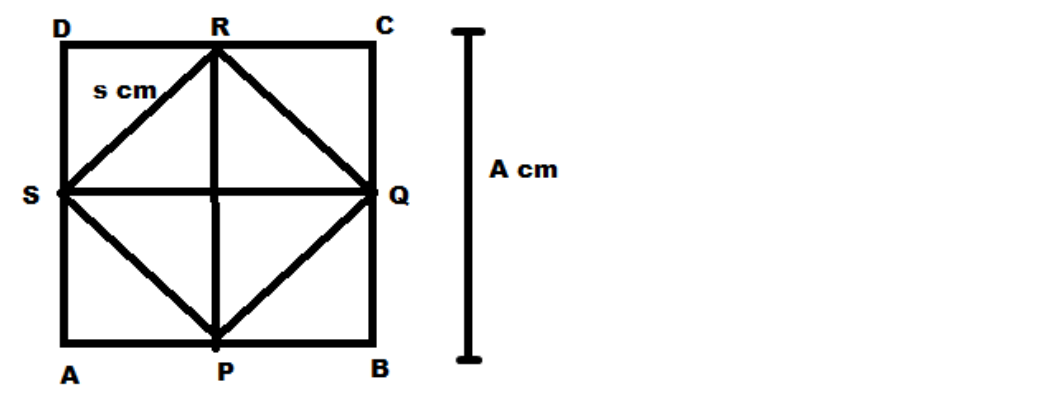
The area of square ABCD is $16c{m^2}$ . Find the area of the square joining the midpoint of the sides.

A. 8$c{m^2}$
B. 3$c{m^2}$
C. 5$c{m^2}$
D. 9$c{m^2}$

Answer
575.1k+ views
Hint: We are given that the area of square ABCD is $16c{m^2}$. We know that the area of a square is the product of its sides and using this we can find the length of the side of the square ABCD, say A.Now PQRS is the square formed by joining the midpoints of the sides of the square ABCD. The length of the diagonal of the new square is equal to the length of the side of the square ABCD. The length of the diagonal of the square is given by the formula $\sqrt 2 *side{\text{ units}}$. Equating this with the length of the side of the square ABCD we can find the side of the square PQRS and with that, we can find the area of the new square.
Complete step by step answer:
Now we are given a square ABCD whose area is $16c{m^2}$
We know that the area of the square is the product of its sides
Let the side of the square be A
Therefore, with the given area
$
\Rightarrow Area = {A^2}sq.units \\
\Rightarrow 16c{m^2} = {A^2} \\
\Rightarrow A = \sqrt {16} = 4cm \\
$
We have that the side of the square is 4 cm
Now a square PQRS is formed by joining the midpoints of the side of the square ABCD

Let the side of the square PQRS be s cm
We can see that the diagonal of the square PQRS is equal to the side of the square ABCD
Length of the diagonal of a square is given by $\sqrt 2 *side{\text{ units}}$
Therefore,
Diagonal of PQRS = Side of ABCD
$
\Rightarrow \sqrt 2 s = A \\
\Rightarrow \sqrt 2 s = 4 \\
\Rightarrow s = \dfrac{4}{{\sqrt 2 }} \\
$
Now multiplying and dividing by $\sqrt 2 $
$
\Rightarrow s = \dfrac{4}{{\sqrt 2 }}*\dfrac{{\sqrt 2 }}{{\sqrt 2 }} = \dfrac{{4\sqrt 2 }}{2} \\
\Rightarrow s = 2\sqrt 2 cm \\
$
From this the area of the square PQRS is given by ,
\[
\Rightarrow Area = {s^2}sq.units \\
\Rightarrow Area = {(2\sqrt 2 )^2} \\
\Rightarrow Area = 4*2 = 8c{m^2} \\
\]
The correct option is A.
Note: we can find the length of the square when a diagonal is given
if the diagonal of the square is D and let the side be s
so the side is given by $s = \sqrt {\dfrac{D}{2}} $ units
The perimeter of a square is 4 times the length of one side. A square has a larger area than all other quadrilaterals with the same perimeter. The diagonals of a square bisect each other at 90 degrees and are perpendicular.
Complete step by step answer:
Now we are given a square ABCD whose area is $16c{m^2}$
We know that the area of the square is the product of its sides
Let the side of the square be A
Therefore, with the given area
$
\Rightarrow Area = {A^2}sq.units \\
\Rightarrow 16c{m^2} = {A^2} \\
\Rightarrow A = \sqrt {16} = 4cm \\
$
We have that the side of the square is 4 cm
Now a square PQRS is formed by joining the midpoints of the side of the square ABCD

Let the side of the square PQRS be s cm
We can see that the diagonal of the square PQRS is equal to the side of the square ABCD
Length of the diagonal of a square is given by $\sqrt 2 *side{\text{ units}}$
Therefore,
Diagonal of PQRS = Side of ABCD
$
\Rightarrow \sqrt 2 s = A \\
\Rightarrow \sqrt 2 s = 4 \\
\Rightarrow s = \dfrac{4}{{\sqrt 2 }} \\
$
Now multiplying and dividing by $\sqrt 2 $
$
\Rightarrow s = \dfrac{4}{{\sqrt 2 }}*\dfrac{{\sqrt 2 }}{{\sqrt 2 }} = \dfrac{{4\sqrt 2 }}{2} \\
\Rightarrow s = 2\sqrt 2 cm \\
$
From this the area of the square PQRS is given by ,
\[
\Rightarrow Area = {s^2}sq.units \\
\Rightarrow Area = {(2\sqrt 2 )^2} \\
\Rightarrow Area = 4*2 = 8c{m^2} \\
\]
The correct option is A.
Note: we can find the length of the square when a diagonal is given
if the diagonal of the square is D and let the side be s
so the side is given by $s = \sqrt {\dfrac{D}{2}} $ units
The perimeter of a square is 4 times the length of one side. A square has a larger area than all other quadrilaterals with the same perimeter. The diagonals of a square bisect each other at 90 degrees and are perpendicular.
Recently Updated Pages
Master Class 10 General Knowledge: Engaging Questions & Answers for Success

Master Class 10 Computer Science: Engaging Questions & Answers for Success

Master Class 10 English: Engaging Questions & Answers for Success

Master Class 10 Social Science: Engaging Questions & Answers for Success

Master Class 10 Maths: Engaging Questions & Answers for Success

Master Class 10 Science: Engaging Questions & Answers for Success

Trending doubts
The shortest day of the year in India

Why is there a time difference of about 5 hours between class 10 social science CBSE

Write a letter to the principal requesting him to grant class 10 english CBSE

What is the median of the first 10 natural numbers class 10 maths CBSE

The Equation xxx + 2 is Satisfied when x is Equal to Class 10 Maths

State and prove converse of BPT Basic Proportionality class 10 maths CBSE




